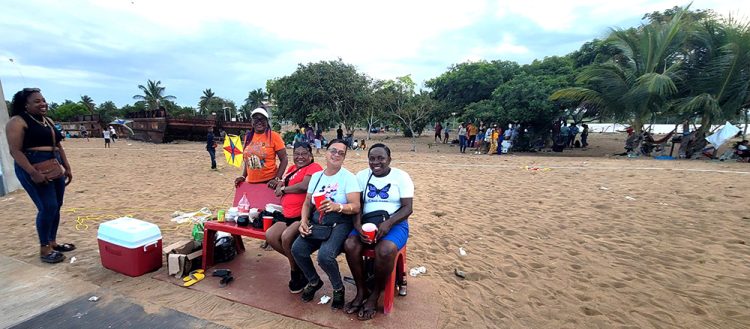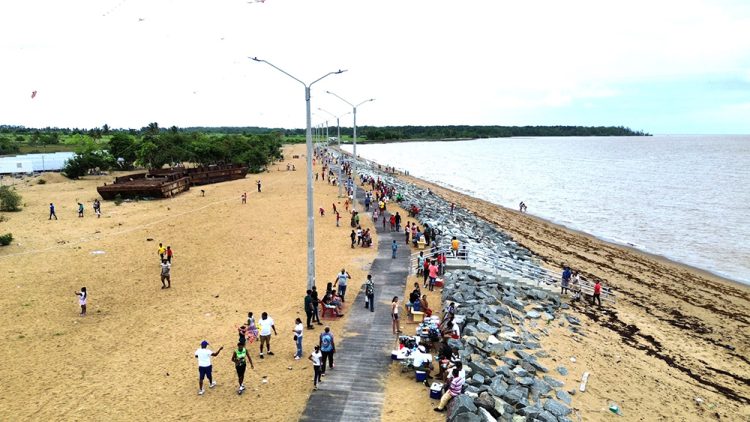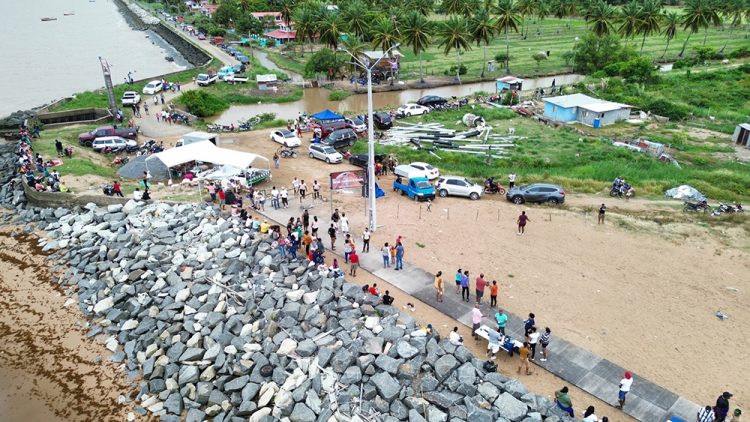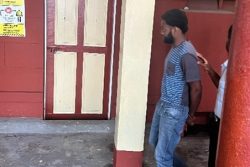By Telesha Ramnarine
For the first time ever, residents of Leguan Island in the Essequibo River had a place to call their own for Easter, as hundreds flocked to the newly developed Canefield Beach. Once obscured by thick shrubbery and largely forgotten by locals, the beach has blossomed into a popular recreational spot, thus improving the landscape and tourism potential of the island.
Located at an area called Okum/Retrieve, where a rip rap sea defence structure has been completed, Canefield Beach features a walkway, lights, washrooms, seating accommodation, and steps that lead down into the water so that visitors do not have to climb over the rocks.
“The beach has a lot of potential and can make Leguan a great tourist attraction. Future plans for it are in the making,” Fajina Khan, a beach committee member, told Stabroek Weekend recently. “This year, I think the beach, our beach, made Easter more exciting for the residents since they had a unique and beautiful place of their own to go. The beach catered for the entire island and we even had persons from Wakenaam and the West Coast spending Easter with us at the beach.”

Kite flying on the Easter weekend was the first major event since the beach development started, so everyone was excited to go and experience it. Even though the concept of promoting the beach was always there, Khan related that it was only last August that work on the actual beach commenced after the rip rap work was completed and the sea defence for the entire area was secured.
Canefield Beach is no accident; it represents strategic development and community vision. What began as a government project to reinforce river defences has transformed into a vibrant public space, now hailed as one of the most scenic spots on the island, and possibly in the entire Region Three (Essequibo Islands–West Demerara).

Regional Chairman Sheik Ayube is proud of the beach’s growing popularity, not only among locals but also visitors from outside the region. With future plans including a hotel and continued upgrades, he believes that this could become a true tourist hotspot.
Three years ago, few could have imagined this transformation as the area was inaccessible, overgrown with bushes. But with the collaboration of the Ministry of Public Works and local authorities, the underbrush was cleared and the unique natural landscape began to shine through.
Unlike traditional dam projects that rely on concrete and stone, the Canefield shoreline features a distinctive, layered design. A sandy dam was constructed above the rip rap, resulting in two beaches—one elevated and one at river level. The result: a beach experience untouched by the rising tides of the Essequibo River, offering safe and uninterrupted recreation year-round.

Locals are now imagining a future where tourism can complement agriculture, therefore boosting the island’s economy. Traditionally reliant on rice farming, cattle rearing, and cash crops, Leguan is now opening the door for economic diversification, providing different avenues for residents to earn money.
All enhancements to the beach so far have been carried out by the Ministry of Public Works with close support from the local beach committee. The Neigh-bourhood Democratic Council and Regional Democratic Coun-cil have also pitched in when needed to maintain the area’s upkeep.
Meanwhile, according to Khan, Canefield Beach is just one piece of a broader wave of development sweeping across Leguan. Under President Irfaan Ali’s administration, she pointed out, the island has seen significant infrastructure upgrades. The main public road is currently under rehabilitation by the Ministry of Public Works’ Special Projects Unit, and a new solar farm is on track to integrate with the Guyana Power and Light system. Schools, playgrounds, and sea defence structures have also received notable attention.









